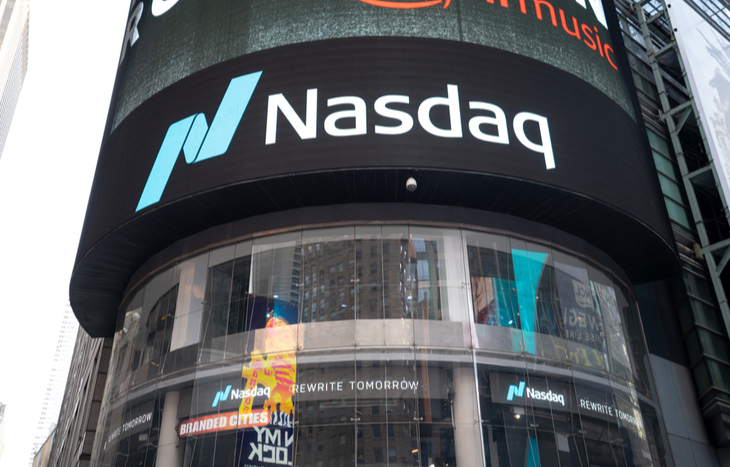What is the NASDAQ?
When searching for a stock ticker, there’s always a prefix in front of it: the exchange where the company publicly lists its shares. Commonly, companies choose to list on the NASDAQ. This is a computerized marketplace for the buying and selling of securities traded over the counter—and even some NYSE listings. It’s an acronym for National Association of Securities Dealers Automated Quotations (NASDAQ).
The NASDAQ is a modern-day pillar of the stock market: one of the two powerhouse exchanges investors turn to every day to facilitate trades. It has a long and storied history, and continues to evolve as one of the world’s largest securities marketplaces. Here’s a look at the NASDAQ and its role in the investment world.

History of the NASDAQ
NASDAQ was the world’s first electronic securities marketplace, created by the National Association of Securities Dealers (NASD)—known as the Financial Industry Regulatory Authority (FINRA) today. It was a revolutionary step toward digital quoting and trading, at a time when buying and selling largely took place in-person or over-the-phone. It quickly rose to prominence as a preferred marketplace for tech companies to list and trade their stock.
The technology powering the NASDAQ is what propelled it to prominence, and other exchanges quickly adopted its methods. Through the years, the exchange grew not only in the number of companies that chose to list with it, but also through mergers and acquisitions with other exchanges. In the early 2000s, it combined with OMX Group, a Scandinavian exchange, to become the world’s largest exchange company.
Today, NASDAQ lists roughly 3,700 companies, and one in 10 trade transactions happens within its marketplace. It’s become the preferred exchange for new companies listing shares publicly and one of the largest financial entities in the world thanks to its partnerships and stakes in exchanges across the globe.
Major Companies Listed on the NASDAQ
Originally focused on listing shares for tech companies, the NASDAQ remains very tech-focused today. This is evident in the top-heavy collection of tech companies that comprise the exchange’s biggest tickers. Some of the biggest by market cap include:
- Apple (NASDAQ: AAPL), $2.287 trillion
- Microsoft (NASDAQ: MSFT), $1.749 trillion
- Amazon (NASDAQ: AMZN), $1.608 trillion
- Alphabet (NASDAQ: GOOG), $1.241 trillion
- Facebook (NASDAQ: FB), $735.8 billion
Tech stocks make up just shy of 50% of total NASDAQ listings. Consumer services make up another 20%, while healthcare comes in at 10% of companies listed. The remaining 20% of companies listed on the NASDAQ split fairly evenly across financials, industrials and consumer goods. There are very few utilities, telecoms, materials, and oil and gas companies listed on the exchange.
The NASDAQ Composite Index (NASDAQ: IXIC) mirrors these allocations, giving investors the opportunity to invest in virtually every company listed with the exchange. There’s also the NASDAQ 100 (NASDAQ: NDX), which includes the largest ~100 securities from the NASDAQ. Both are market cap weighted indices.
How the NASDAQ Works
When companies go public, they need to choose an exchange to list shares on. Many companies choose the NASDAQ because of its lower barrier to entry, as opposed to the NYSE or other exchanges. Listing typically costs a new company between $55,000-$80,000 depending on the number of shares issued at IPO. There’s also an annual fee of $43,000-$77,000 to maintain the listing.
This is relatively affordable compared to the NYSE, which charges $150,000-$295,000 to list and the greater of $0.00113 per share or $71,000 to maintain the listing.
Once listed, investors have the ability to buy and sell shares of companies on the NASDAQ exchange. Unlike the NYSE which has designated market makers, NASDAQ is a dealer market: market makers compete with one another. Dealers maintain an inventory of shares and facilitate buying and selling using their own shares. There are more than 260 such market makers competing within the NASDAQ marketplace, which ensures buyers and sellers get the best prices on bid-ask.
Interesting Facts
Throughout its history, the NASDAQ has been something of a trailblazer for electronic trading. It has also paved the way for new forms of market governance and standards. There are several very interesting facts about the exchange that have contributed to its rise to one of the world’s most prominent.
- NASDAQ isn’t one single market; rather, it’s a collection of them. NASDAQ operates 25 markets, one clearinghouse and five central securities depositories.
- As of 2019, NASDAQ is also involved in cryptocurrency exchange. The platform currently collaborates with seven crypto exchanges to facilitate trades.
- In 2020, the NASDAQ proposed a rule to the SEC requiring board of director diversity of at least one female and one underrepresented minority, in a bid to promote inclusion.
- Over 90 exchanges in more than 50 countries use the trading technology pioneered by NASDAQ.
The NASDAQ continues to be one of the most innovative and forward-thinking exchanges in the world. As one of the largest, it also sets precedent for many other exchanges. It continues to be a force for change in the investing world.
A Pillar of the Modern Stock Market Environment
Today, almost all securities exchanges happen digitally. This is possible thanks to the technology pioneered by the National Association of Securities Dealers Automated Quotations (NASDAQ).
To learn more about the various exchanges and how you can benefit as an investor, sign up for the Investment U e-letter below. You will find invaluable insights from some of today’s most experienced Wall Street experts!
This competitive marketplace of market makers ensures free-flowing exchange of stock at optimal prices, bringing liquidity to the market and accessibility to investors around the world. It’s not only a place where companies list shares and investors come to trade them—it’s a pillar of the modern stock market environment.
[adzerk-get-ad zone="245143" size="4"]




